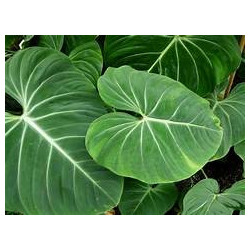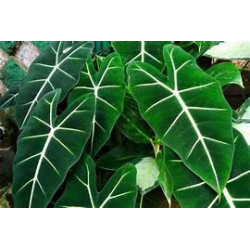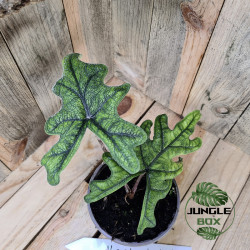Subcategories
-
Philodendron
Philodendron is a genus of tropical perennial plants belonging to the Araceae family, known for their large, decorative leaves and ease of care. These plants are popular as houseplants due to their attractive foliage and adaptability to indoor environments.
🌱 Botanical Characteristics
-
Foliage:
Philodendrons feature large, often heart-shaped or arrow-shaped leaves, though some species have deeply lobed or cut leaves. The colors range from vibrant green to dark green, with some varieties, like Philodendron 'Red Emerald', showing red or purple hues. -
Flowers:
Like most plants in the Araceae family, Philodendrons produce flowers in the form of spathes surrounding a spadix. However, their flowers are usually small and not very ornamental, and Philodendrons are primarily grown for their foliage. -
Mature Size:
Philodendrons vary significantly in size depending on the species. Some, like Philodendron scandens, remain relatively small (around 30 to 60 cm), while others, like Philodendron bipinnatifidum, can grow up to several meters tall. -
Growth Habit:
Philodendrons can have a creeping, climbing, or upright growth habit. Climbing varieties need a support or trellis to grow on, while upright types form compact bushes.
🪴 Care and Cultivation
-
Light:
Philodendrons prefer bright, indirect light but can tolerate low light conditions. However, too little light may slow down their growth and cause the loss of vibrant leaf colors. Avoid direct sunlight, as it can scorch the leaves. -
Temperature:
These plants thrive in warm temperatures, ideally between 18°C and 25°C (64°F to 77°F). They are sensitive to temperatures below 10°C (50°F) and should be protected from cold drafts. -
Humidity:
Philodendrons prefer moderate to high humidity but adapt well to average room humidity. More tropical varieties, like Philodendron gloriosum, require higher humidity to thrive. -
Watering:
Water moderately, allowing the soil to dry slightly between waterings. Be careful not to overwater, as this can lead to root rot. Ensure the pot has good drainage. -
Soil:
A well-draining, lightweight potting mix is essential for Philodendrons. A mix formulated for houseplants, with added perlite or sand, works well. Avoid heavy or compacted soils. -
Fertilization:
Feed Philodendrons with a balanced liquid fertilizer during the growing season (spring and summer). Reduce or stop fertilizing in fall and winter when the plant is less active.
🌱 Propagation
-
By Stem Cuttings:
Philodendrons are easy to propagate from stem cuttings. Take a cutting with at least one node and place it in water or moist soil to encourage rooting. -
By Division:
Some species of Philodendrons, especially bushy types, can be divided during repotting to create new plants.
🌍 Uses
Philodendrons are mainly grown as houseplants due to their decorative foliage and low maintenance. Some, like Philodendron hederaceum, are great for hanging baskets, while others, like Philodendron bipinnatifidum, are ideal for large pots or corner displays.
🌟 Popular Philodendron Varieties:
-
Philodendron scandens (or Heartleaf Philodendron) – A small, trailing variety with heart-shaped leaves.
-
Philodendron bipinnatifidum (or Tree Philodendron) – A larger species with deeply divided, ornamental leaves.
-
Philodendron gloriosum – A stunning variety with large, velvety leaves and striking white or silver veins.
-
Philodendron selloum – A large, deeply cut-leaf variety, perfect for adding a tropical look to any space.
Philodendrons are versatile plants that adapt well to various indoor environments. They are not only aesthetically pleasing but also easy to care for, making them an excellent choice for both beginner and experienced gardeners. 🌿
-
-
Alocasias
Alocasia are tropical perennial plants from the Araceae family, known for their large, impressive leaves and exotic appearance. They are especially appreciated for their ability to add a jungle-like touch to indoor spaces.
🌱 Botanical Characteristics
-
Foliage:
Alocasia plants have large, often arrow-shaped or heart-shaped leaves. They come in a variety of colors, including dark green, silver, purple, or sometimes marbled. Some varieties, like Alocasia Polly, feature green leaves with distinct white or silver veins. The leaves are typically thick, waxy, and glossy, giving them a robust and striking appearance. -
Flowers:
The flowers of Alocasia are not as decorative as the foliage. They resemble the spathes of other plants in the Araceae family, but they are typically small and less showy. The plant is more valued for its beautiful leaves than its flowers. -
Mature Size:
The size of Alocasia plants varies depending on the species. Some varieties stay relatively small, around 30 cm (12 inches) in height, while others, like Alocasia macrorrhizos, can grow over 2 meters (6 feet) tall. -
Growth Habit:
They have an upright or erect growth habit, with thick, fleshy stems supporting their large leaves. Some varieties can also have a slightly bushy appearance.
🪴 Care and Cultivation
-
Light:
Alocasia prefers bright, indirect light. They can tolerate some shade, but too little light can lead to slow growth and a loss of the vibrant colors in their leaves. -
Temperature:
These plants thrive in warm temperatures, ideally between 18°C and 26°C (65°F to 79°F). They are sensitive to temperatures below 10°C (50°F) and should be protected from cold drafts. -
Humidity:
Alocasia requires high humidity, ideally around 60% or more. A humid environment, such as a room with a humidifier or a greenhouse, is perfect for their development. -
Watering:
Water moderately, allowing the soil to dry slightly between waterings. Avoid letting the plant sit in soggy soil, as overwatering can lead to root rot. Make sure the pot has good drainage. -
Soil:
A well-draining, lightweight potting mix enriched with organic matter is recommended. A tropical plant mix with perlite or sand can help improve drainage. -
Fertilization:
During the growing season (spring and summer), fertilize with a balanced liquid fertilizer every month. Reduce or stop fertilizing in the fall and winter when the plant is less active.
🌱 Propagation
-
By Stem or Rhizome Cuttings:
Alocasia can be propagated by dividing rhizomes or taking stem cuttings. Young shoots or rhizomes should be separated and replanted in moist soil to encourage growth.
🌍 Uses
Alocasia are primarily grown as houseplants. Their striking foliage and large size make them a focal point in interior decor. They also work well in terrariums or large planters, adding a tropical touch to a space.
🌟 Popular Alocasia Varieties:
-
Alocasia Polly (or African Mask Plant) – A compact variety with arrow-shaped leaves and silver veins.
-
Alocasia macrorrhizos (or Giant Taro) – A large variety with huge leaves and an imposing growth habit.
-
Alocasia portodora – Another large variety with broader, rounded leaves.
Alocasia are spectacular plants, ideal for tropical plant enthusiasts, but they do require special attention regarding temperature, humidity, and watering. When well cared for, they can become a stunning decorative feature in any room. 🌿
-
-
Syngonium
-
Anthurium
-
Scindapsus (Epipremnum)
-
Schismatoglottis





